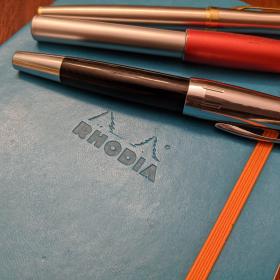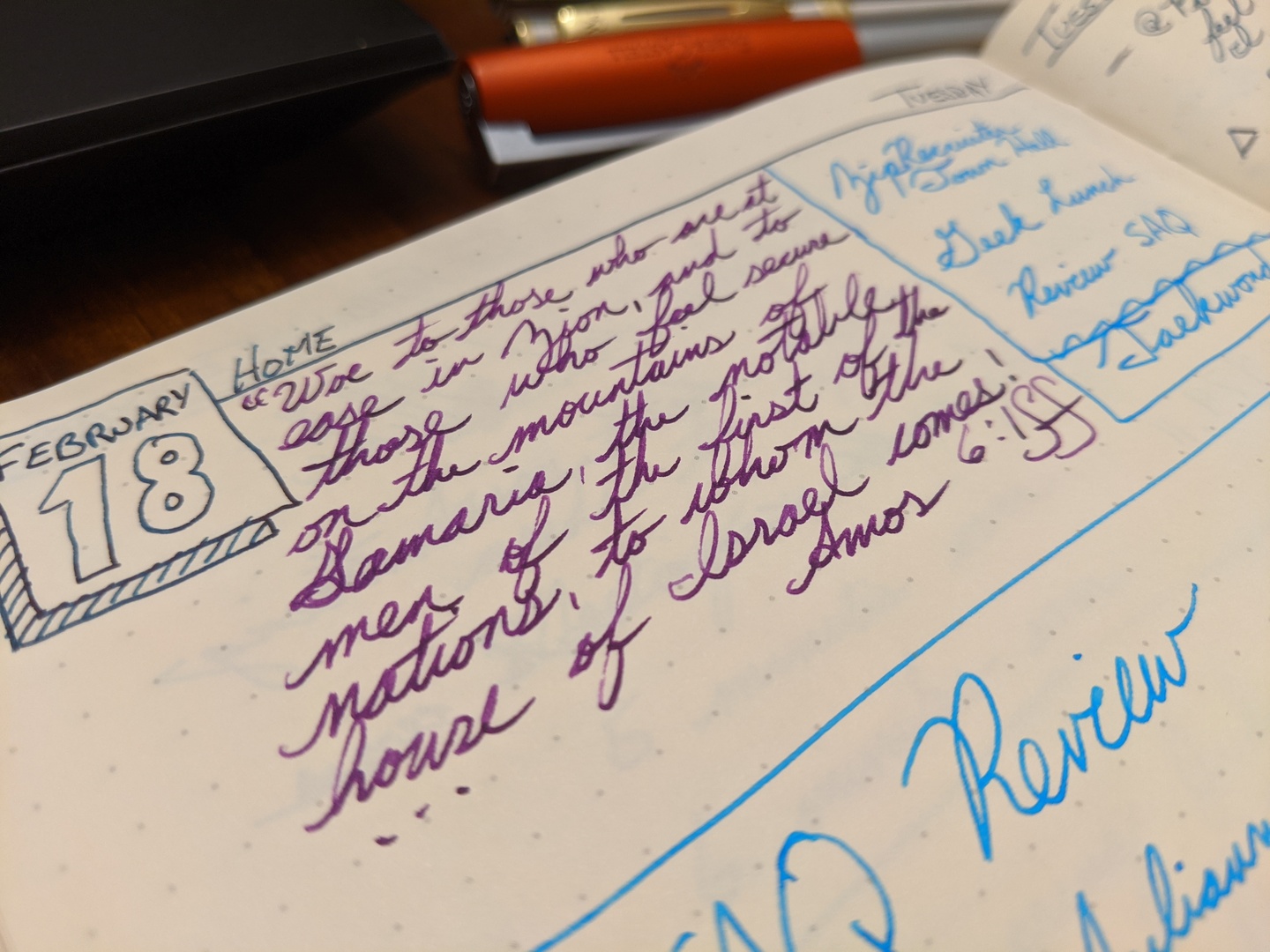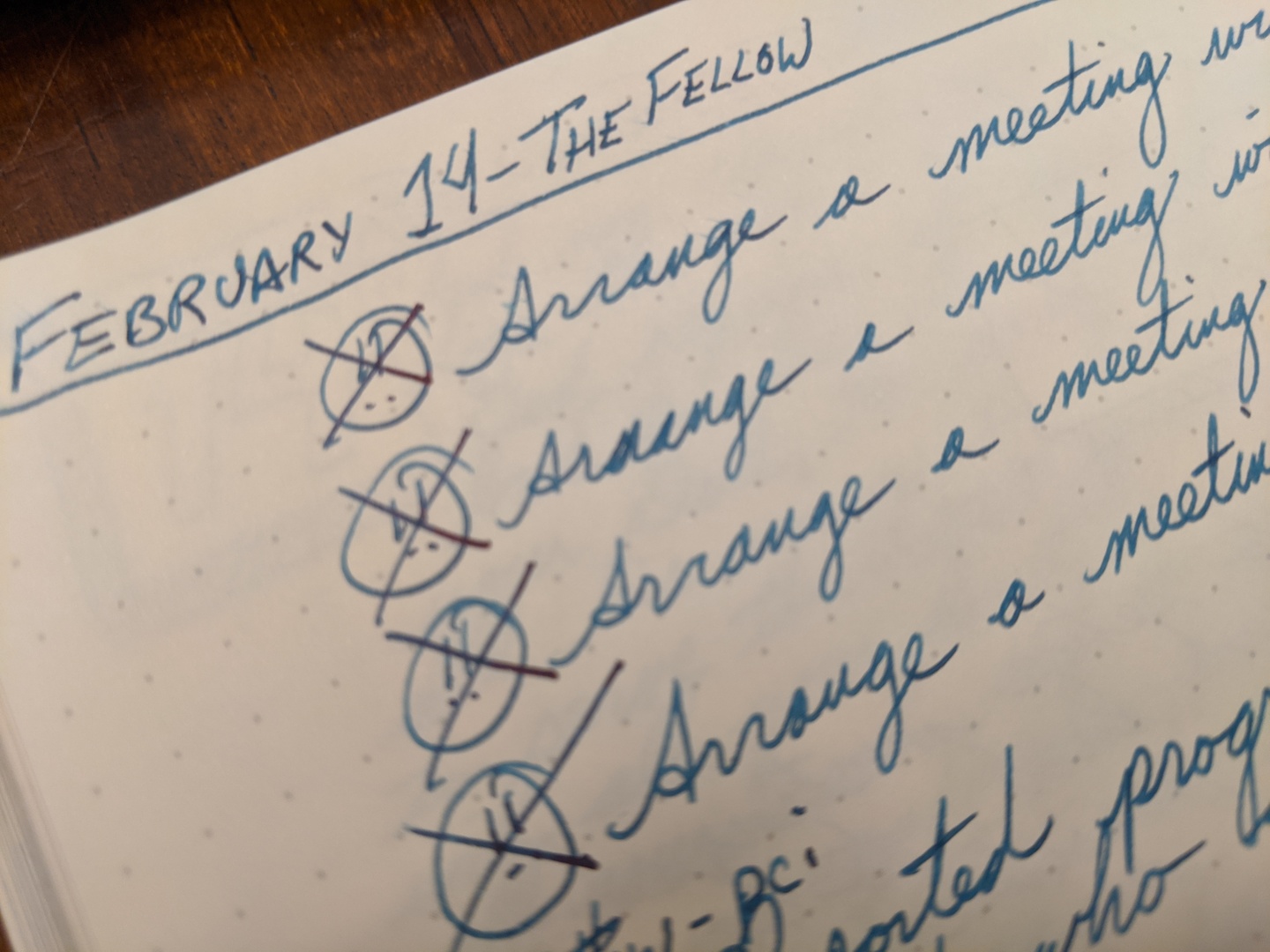Work Journaling, My Way

I recently had some friends ask me to describe my work-journal, so here we go. I am here giving a snapshot of my current journaling practices. When it comes to organization, I am not very consistent. In fact, between the first draft and publishing, I changed some of the details already. So, let’s hurry this up before I change something more drastically.
The Tools
I keep two separate journals: one for work and one personal. The work journal is the one I use more regularly and is more structured, but both are pretty similar in overall form. I am focusing on the work journal here. My preferred notebook is the Rhodia Goalbook. This is an A5 size notebook with a dot grid, a table of contents, a monthly calendar, a daily calendar, and pre-printed page numbers. The paper in this notebook is thick and absorbent, which is very important to me since my preferred writing utensil is a fountain pen. I started collecting those a couple of years ago, but lets not get started there. This will be long enough already.
Anyway, I also keep a sheet of blotting paper with my notebook to help avoid smudges or getting ink from one page on the facing page when I need to close the journal right after writing. When writing with a fountain pen or gel pen, I highly recommend some kind of blotter. Just about any paper will do, but blotter paper lasts forever at this purpose.
In the past I’ve also made use of Leuchtterm1917 notebooks, but I like the Rhodia notebooks much better. Moleskine notebooks would be fine for blotting paper or maybe tearing the pages out for firestarters.
Start of Day Ritual
Every morning at the start of my day. I open to the first blank page and add the first heading. To set each page apart from the previous day, I block out a 4 by 4 area to show the current date. Then, I add a top line and my current location and the current day of week. I find it is helpful for recalling details later to know where I was when I took the notes.
Next, I block out a 10 block wide section to put in the day’s appointments. Generally, this just lists them out. My Google Calendar will alert me to specific times and such. The reason I write them out is that by doing so I’m forced to look at my calendar for the day and see what appointments I have. This goes a very long way toward keeping me from missing meetings and other important events.

Then, I go into my personal email and find the latest scripture of the day my father-in-law has sent me. He has for many years sent out a daily email with a scripture reference in it. This way I always start my day grounded. I then copy out the first 2 or 3 verses on the page and write the reference. I then finish reading the rest and meditate on it.
After that, I start a task I recently added to the process. I open up my work email and look at the number of emails that have been sent in the past 24 hours and write that number out along with the current total count for my inbox. This is another a little ritual that has no importance in and of itself, but by doing it, I am forced to look at my email. Then I go through every message that has come through since the last time I checked and see if anything stands out as it might be useful or interesting. I open it, skim it, and then write down a bulleted note about it if there is something worth noting.
And then, I open up Slack and look through messages in my starred channels there. I again take down a note for anything interesting in the chats since I last looked, or note any discussions this immediately brings me into. Again, in this way, I avoid missing something important in my Slack channels.
Both this process and the inbox notes were added recently because I was needing to do even more collaboration than I’ve had to do in the past. I noticed I was doing poorly at this. These little adjustments to my journaling have gone a long way towards improving my communication and attentiveness to what’s going on in other groups at work.
That’s the end of the start-of-day ritual.
Not Bullet Journaling

For the rest of the day, I write bulleted notes every time I do or learn something. Sometimes my notes get really detailed and mundane. Some days I get really focused on a heads-down task and forget to take any notes. It depends on what I’m doing and where my focus is. I don’t ever try to force it.
Everything after the verse of the day generally involves bulleting. There is a thing called bullet journaling, but I break most of the rules of bullet journaling badly enough that I don’t think I’d call it that. I invented some of it myself before learning about bullet journaling. Since learning about it, I have borrowed some concepts from bullet journaling to enhance what I do.
I place a line of white space above and below all bullets and leave margins on the outside of every page, so I can make additional scribbles and notes when needed.
Here are my bullets:
-
For general notes I use a dash or even no bullet at all.
-
For actions I take, I use a triangle for my bullet.
-
For notes of any kind related to my previous note I use an arrow pointing down and to the right.
-
For anything important that needs to catch my eye, I put a circle around a symbol. I can pick these out easily on the page later.
-
For tasks I need to complete, I use a double bang inside a circle.
-
For questions I want to answer, I use a question mark inside a circle.
-
For important notes I believe I will want to be able find later, I use an asterisk inside of a circle.
-
Sometimes I use other kinds of bullets, like a dollar sign for a note about money, a plus sign for a note about bonus.ly given or planned to be given to coworkers, or an at sign to help call out a note for or about a specific person.
To mark a task as completed or a question as answered, I cross it out with an “X”. If I decide I won’t complete that task or won’t answer that question later, I will strike it out with a line through it.
My notes are rarely in shorthand unless I’m in a meeting and need to write fast. I like writing. And writing with a fountain pen is very easy on the hands too. Therefore, I write all my notes longhand. This helps keep me focused and also means I don’t have to try and decipher what I meant when I come back 3 months later.
Weekly Migration
Every week or so I perform a “migration,” which is a task I adopted from bullet journaling. I do this a lot more frequently than a typical bullet journal though. This is because my long hand notes mean that my tasks would be spread across dozens of pages quickly if I didn’t. I also try to get through my tasks very quickly. I don’t like to keep long term tasks, so I try not to have them at all. If something is a long term task (further out than a month), then it belongs in a ticketing system or a spreadsheet somewhere, not my notebook.
Migration is the process of looking back and finding any tasks or questions from previous pages and reevaluating them. Whenever I do a migration I make a mark circled down arrow in the header of the page where the migration. I know that I don’t have to go any further back than that page during the process next time. Then for each circled item, I review it.
Regarding tasks:
-
Completed tasks are crossed out.
-
I strike a task if I’m not going to do it or it’s old (sometimes copying it to a ticketing system or whatever).
-
For any task I still plan to I circle it again, draw a line forward, and write down the page number of my current journal page. Then, I copy the task onto my current page.
I give similar treatment to questions, though usually don’t copy them forward. If I still don’t have an answer, I usually just leave the questions alone. Life is full of unanswered questions.
Other Stuff
That’s the day-to-day journaling bits. I have tried to make use of monthly or annual calendars, project pages, and the like, but it didn’t last. Project pages can be helpful when I’ve got several different large projects to track at once, so I might make use of project-style pages again, but I’m not doing it right now.
Long term calendar pages are pretty useless for me. If it’s really important and long term, I’ll just put in a ticket at work.
I do, however, keep a detailed table of contents, which I fill in every migration or two. I make contents entries for things like:
-
The first day of each week.
-
The first page of any meeting notes.
-
Any project pages (when I have them).
-
Any other thing I think might be notable.
The table of contents is pretty useless most of the time, but it becomes invaluable about once or twice a quarter. It is also a nice way to look back at a few months and see how much I’ve accomplished on just a couple pages.
That’s about it.
Cheers.
